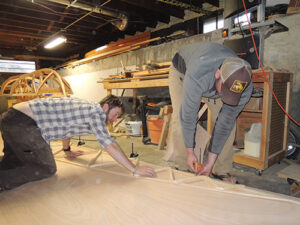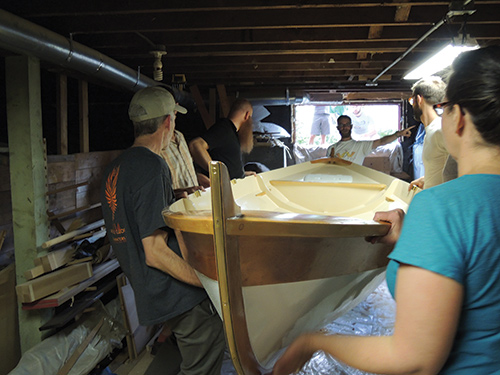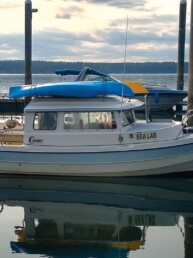
We’ve all heard jokes about the guy who builds a boat in his basement, but who knows the punch line? Well, my family and I do, now.
I raised a skeptical eyebrow when my friend Bill, an aspiring woodworker, told me about his construction project. Oh, the lapstrake rowing boat sounded nice enough. It was a modern classic designed by Joel White to row and sail. The thing was, Bill was building the boat in his cellar. And a primary consideration in choosing the design, he confided, was whether the finished boat would fit through the window— which was the only means of getting it out of his workshop in one piece.
My family was even more dubious and intrigued about this venture than I was. They like boating just fine, but after they’ve been dragged along to more than one maritime event or another over the years, it can be challenging to get them excited about anything boat-related. But when I mentioned Bill’s project one night at dinner, my kids nearly jumped out of their seats with curiosity. And soon enough, the questions began flowing.
“His window is about twice the size of that skinny one over our couch,” I said, gesturing towards the living room. Although we’d lived in the house for a dozen years, everyone studied that window as if it had just materialized.
“That would make it about two by four feet,” Simon calculated aloud.
I could see the wheels turning in Nate’s mind. He grinned, “There’s no way a boat is going to make it out of a window that small.”
My wife just shook her head, inured by now to the odd notions that take possession of sailors. After asking a few questions herself, even she conceded that a guy pushing a finished boat through a basement window sounded like something worth seeing.
In the ensuing months of scarfing, planing, and epoxying that it takes to build a glued lapstrake craft, I occasionally stopped by to see the progress in Bill’s subterranean workshop. Each time I descended the narrow stairs from his modest kitchen, I had to duck to avoid a joist on the way into the basement. There was no way anything as rigid as a boat could pass this way. The window placed high on the concrete wall opposite the stairs was the only possible way out. But would it be big enough? I would routinely stare up at the daylight hoping that Bill’s calculations were correct.
On each visit, I eyeballed the beam, and the increasing depth of the craft and compared it to the opening. The craftsmanship on the boat was excellent. The spiled planks met the stem cleanly—no epoxy filler there. Still, a boat is a challenging thing to build exactly, or to measure with all the curves and odd angles. Could he have deviated a tiny bit from the plans? Would Bill need to remove some of the window framing to get the boat out? Maybe he’d have to shave off the gunwales at the last minute? Bill was consistently resolute on the plan. Only time would tell if it would work.

It had been a few months since I’d heard from Bill, when an invitation for a “defenestration party” arrived in my inbox. My family cheered as I read it aloud. It concluded: “The particularly exciting part is that the boat is 16 feet long, just over 4 and a half feet wide, and weighs in the neighborhood of 140 pounds. So, as you can imagine, I need a bit of help. Oh, and many people don’t think it will fit out the window (I do have a younger brother, after all). I think you should be there to find out.”
There was no doubt that my clan would be present to cheer (or laugh). And when my kids arrived on that summer’s eve, they eyeballed the window with just as much doubt as I had.
“It’s going to get stuck!” Nate whispered to me, barely able to contain his anticipation… and laughter.
“Well, Bill tells me he’s measured it,” I said, trying not to chuckle.
Bill’s invitation had been specific about those measurements: “I’ll have about half an inch on either side of the boat at its widest point,” he’d informed us all confidently. “It’s going to be fun. Upon successfully passing the widest part of the boat through the window, there may be cheering.”
Speculation was rife as a crowd of a dozen people gathered, some in the basement, others in the yard, poised outside the window to help maneuver the boat out. With the basement crew, I grasped the side of the finished boat as Bill instructed us where to stand and how to angle it out. In the tense moment before we lifted his creation, I tightened my grip on the nicely varnished gunwale. There’s a fine line between laughing and crying, I thought. In the next few seconds, Bill would probably do one or the other.
What happened next astonished my kids and almost everyone else. Five or six sailors—not all of them particularly burly—hefted the boat off its sawhorses, lifted it toward the small window, and after following Bill’s animated arm motions, angled it neatly through. By the time my wife ran around the house to photograph the phenomenon from the outside, the boat had already been received by the ground crew and set on the grass outside. The entire procedure had taken less than five minutes.
Cheers and shouts greeted Bill as he scrambled out of the basement to pose proudly by his boat. For the next hour, the party crowd kept giddily saying, “I can’t believe it!” Not Bill, though, he just smiled.
Still curious about how to get a boat out of a basement? I know just the man to ask.

You can see Bill’s art and boat projects at his website: www.wessingerwoodworks.com
Bruce Bateau sails and rows traditional boats with a modern twist in Portland, Oregon. His stories and adventures can be found at www.terrapintales.wordpress.com
Bruce Bateau
Bruce Bateau sails and rows traditional boats with a modern twist in Portland, Ore. His stories and adventures can be found at www.terrapintales.wordpress.com






